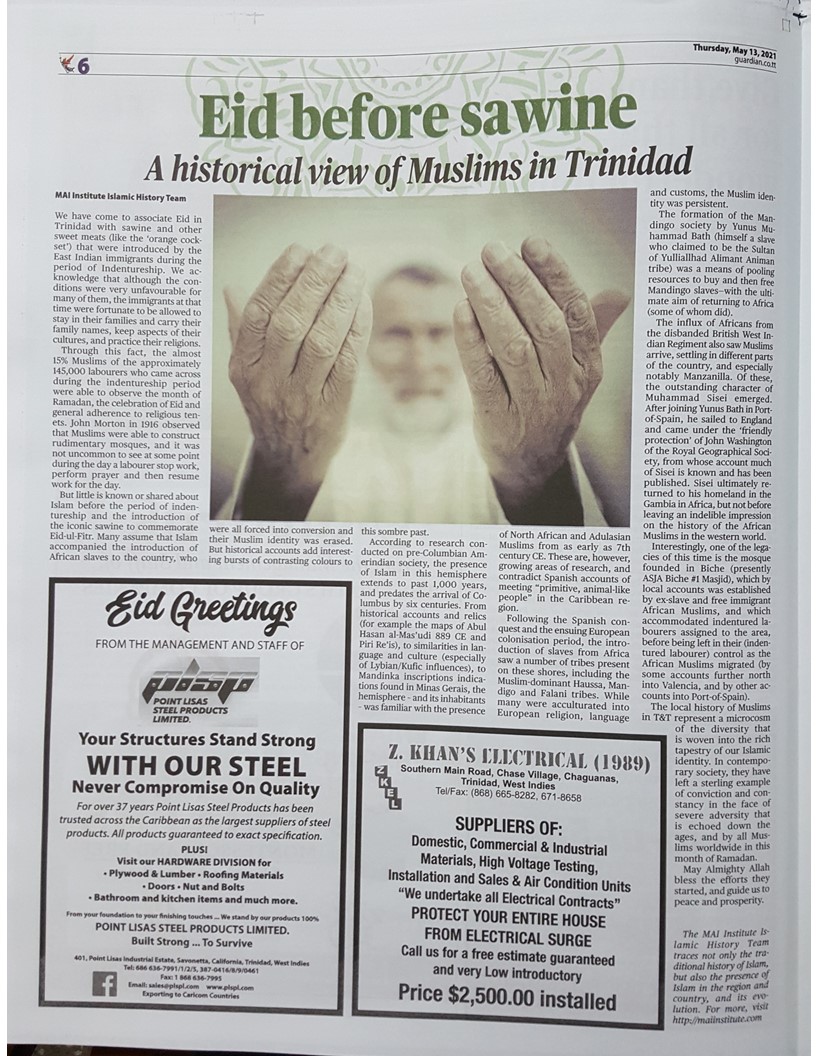EID BEFORE SAWINE: A HISTORICAL VIEW OF MUSLIMS IN TRINIDAD

EID BEFORE SAWINE: A HISTORICAL VIEW OF MUSLIMS IN TRINIDAD
MAI Institute Islamic History Team: We have come to associate Eid in Trinidad with sawine and other sweet meats (like the ‘orange cockset’) that were introduced by the East Indian immigrants during the period of Indentureship. We acknowledge that although the conditions were very unfavorable for many of them, the immigrants at that time were fortunate to be allowed to stay in their families and carry their family names, keep aspects of their cultures, and practice their religions. Through this fact, the almost 15% Muslims of the approximately 145,000 labourers who came across during the indentureship period were able observe the month of Ramadan, the celebration of Eid and general adherence to religious tenets. John Morton in 1916 observed that Muslims were able to construct rudimentary mosques, and it was not uncommon to see at some point during the day a labourer stop work, perform prayer and then resume work for the day.
But little is known or shared about Islam before the period of indentureship and their introduction of the iconic sawine to commemorate Eid-ul-Fitr. Many assume that Islam accompanied the introduction of African slaves to the country, who were all forced into conversion and their Muslim identity was erased. But historical accounts add interesting bursts of contrasting colors to this sombre past.
According to research conducted on pre-Columbian Amerindian society, the presence of Islam in this hemisphere extends to past 1000 years, and predates the arrival of Columbus by 6 centuries. From historical accounts and relics (for example the maps of Abul Hasan al-Mas’udi 889 C.E. and Piri Re’is), to similarities in language and culture (especially of Lybian/Kufic influences), to Mandinka inscriptions indications found in Minas Gerais, the hemisphere – and its inhabitants – was familiar with the presence of North African and Adulasian Muslims from as early as 7th century CE. These are, however, growing areas of research, and contradict Spanish accounts of meeting “primitive, animal-like people” in the Caribbean region.
Following the Spanish conquest and the ensuing European colonization period, the introduction of slaves from Africa saw a number of tribes present on these shores, including the Muslim-dominant Haussa, Mandigo and Falani tribes. While many were acculturated into European religion, language and customs, the Muslim identity was persistent.
The formation of the Mandingo society by Yunus Muhammad Bath (himself a slave who claimed to be the Sultan of Yulliallhad Alimant Animan tribe) was a means of pooling resources to buy and then free Mandingo slaves – with the ultimate aim of returning to Africa (some of whom did).
The influx of Africans from the disbanded British West Indian Regiment also saw Muslims arrive, settling in different part of the country, and especially notably Manzanilla. Of these, the outstanding character of Muhammad Sisei emerged. After joining Yunus Bath in Port of Spain, he sailed to England and came under the ‘friendly protection’ of John Washington of the Royal Geographical Society, from whose account much of Sisei is known and has been published. Sisei ultimately returned to his homeland in the Gambia in Africa, but not before leaving an indelible impression on the history of the African Muslims in the western world.
Interestingly, one of the legacies of this time is the mosque founded in Biche (presently ASJA Biche #1 Masjid), which by local accounts was established by ex-slave and free immigrant African Muslims, and which accommodated indentured labourers assigned to the area, before being left in their (indentured labourer) control as the African Muslims migrated (by some accounts further north into Valencia, and by other accounts into Port of Spain).
The local history of Muslims in Trinidad and Tobago represent a microcosm of the diversity that is woven into the rich tapestry of our Islamic identity. In contemporary society, they have left a sterling example of conviction and constancy in the face of severe adversity that is echoed down the ages, and by all Muslims worldwide in this month of Ramadan. May Almighty Allah bless the efforts they started, and guide us to peace and prosperity.
The MAI Institute Islamic History Team traces not only the traditional history of Islam, but also the presence of Islam in the region and country, and its evolution. For more, visit https://maiinstitute.com